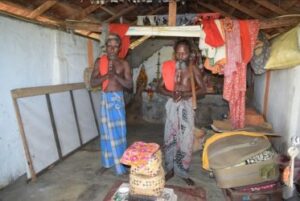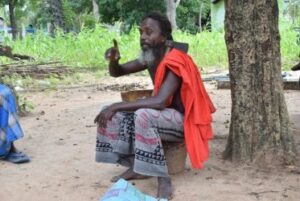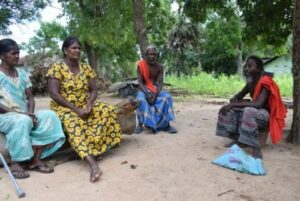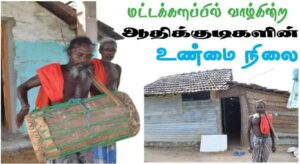

The true situation of the Natives of Batticaloa Moddu Nagaran.

The true situation of the Natives of Batticaloa Moddu Nagaran.
While the histories of Sri Lankan Tamils have been obscured from time to time by the Buddhist chauvinist forces by altering their histories and portraying Tamils as immigrants of the country, it is a matter of concern, that Tamils themselves are still unaware that they are the Natives of Sri Lanka.
Archaeological finds in various parts of the Batticaloa district, especially in relation to the existence of Tamils, have revealed evidence that Tamils lived in the area about 4000 years ago.
The true situation of the Indigenous People living in Batticaloa
Worship of the goddess of hunting
Although the Nagas lived in various parts of Sri Lanka as the dynasty of the Tamils, its histories were destroyed and the Nagas were converted into Sinhalese. Thus, histories were written in Sri Lanka as if they were Sinhalese.
But in recent times there has been a growing interest in archaeology among Tamils and various histories of Tamils are being dug up from various parts of Sri Lanka.
However, no steps have been taken to pass on the excavated Tamil history to the younger generation and that remains a cause for concern.
The antiquity of the Tamils, especially those found in many parts of Sri Lanka, including the Northeast, should be incorporated into the e-reading system and carried out as activities that will be easily readable by future generations
Tamils are indigenous
Tamils are the indigenous people in this country. Steps must be taken to make this world aware that everyone else is an immigrant who came here later.
Tamils are indigenous
Even today, Tamils seem to be indifferent to their own history. This is an opportunity for the majority ethnic (Sinhalese) group to take advantage of this situation. Hence, we have a responsibility to research our traditions and document them.
According to the Adivasis of Sri Lanka the evidence presented by Sinhala researchers, claiming to this day, that the Sinhalese are the natives of Sri Lanka, belongs the Tamils.
They have been trying to portray the Sinhalese as the Natives of Sri Lanka by using the present Adivasis of Sri Lanka.
In this regard, all Tamils carry a collective responsibility to pass on the traditions found among us to our future generations.

Adikudis
As far as Sri Lanka is concerned, Mahiyangana in the south is today internationally recognized as the area inhabited by the ancient settlers. The area is also a popular destination for Sri Lankans and tourists visiting Sri Lanka to see the aborigines and learn about their traditional culture
The Indigenous People of Sri Lanka are Tamils
For quite some time, measures have been taken to supposedly claim the Sinhalese as the Natives of Sri Lanka.
In order to showcase the Sinhala supremacy and to imply them as being Adivasis, the Mahiyangana Adivasi area has been further developed and made more appealing to the masses.
Given the fact, that the original inhabitants of Sri Lanka are Tamil and their descendants are living right in Batticaloa, we come to realize that not enough facilities have been provided to express their Tamil identity associated with it.
Batticaloa Natives | Batticaloa Adivasis of the Eastern Province
There are 74 Adivasi families living in the Kunchangalkulam area of the Madurankenikulam Grama Niladhari Division of the Vagarai Divisional Secretariat Division of the district alone.
Indigenous people have also been living in the Vavuniya Divisional Secretariat Division of the Batticaloa District areas such as Kunchangalkulam, Madurankenikulam, Kirimichai, Kokuvil, Mangeni, Kayankeni, Vattavan, Alangulam, Nasiwandivu, Kuganesapuram, Panichchankeni, Kandaladi, Thattumunai, Palsenai, Ambandaveli, Dikkanavu and Kattumuruvu, Andankulam.
Batticaloa Adivasis make a living by farming, home gardening, beekeeping, fishing and animal husbandry.
The children here are receiving their education at the Madurankenikulam Government Tamil Kalavan School. Nallathambi Velayutham, the leader of the Adivasis Association for the Batticaloa district, lives in the Kunchangalkulam area. Under him, tribals in various villages in the Eastern Province are living.

Worship of the goddess of hunting
They worship their nature deity goddess of hunting right after they wake up in the morning, and only then they go after their daily activities such as farming, gardening, beekeeping and fishing to make a living.
In addition, they regularly engage in discussions with their relatives about issues facing their offspring and changes in their race. After that they go to the forests under their areas and engage in honey extraction. They usually pick honey outside the rainy season.
Although they continue to follow in the footsteps of their ancestors today, due to the progress of time changes in areas of their lives such as diet, speech and education can be observed.
However, ‘We are not given the same recognition and facility opportunities as to the indigenous of other areas!’ says Nallathambi Velayutham, the leader of the Adivasis Association for the Batticaloa district
‘My long-standing wish is that the Batticaloa District Vavuniya Divisional Secretariat should set up a museum with materials that incorporate the practices of your Adivasis. We have lost some of our most valuable antiquities of our community during the last war. It is essential for us to have a museum that can reflect our abundance in traditional and cultural practices.’

‘If it is the Adivasis, only the ones from Mahiyangana matter. We are being ignored’
‘Governments continue to ignore the coastal natives of the Eastern Province. Steps are being taken by government ministers to visit and meet the Adivasis in Mahiyanganai, Thampana and to inquire about their problems in the community.
But even the MPs here do not come and meet us. They are not listening to our grievances,’ said Velayatham, a tribal leader. ‘If it is the Adivasis, only the one from Mahiyangana matter. We are being ignored.’
It may even be an attempt to hide Tamils from the outside world on the grounds that they are indigenous peoples. Those who portrayed the Tamil Adikudis as Sinhalese, are fully aware that Adikudis in Batticaloa cannot be converted into Sinhalese and thus, are reluctant to display Adivasis expressing their true heritage.
In this regard, it is highly regrettable that Tamil politicians are not paying attention to these people who have vastly contributed to the Tamil national struggle.
When complete histories concerning them are written and their traditions are displayed, there is a possibility of a historical resurgence of Tamils. Our expectation is that those on the Tamil national front should make efforts to do so.



